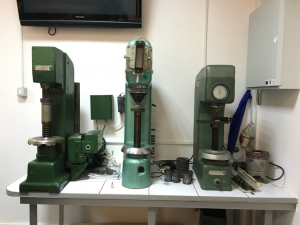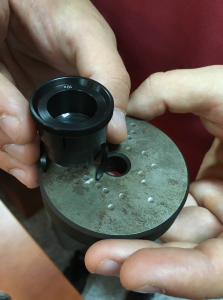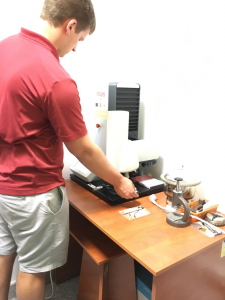Throughout their time in Romania, students are required to write about their experiences that day. Today’s narration comes from Erik Noguez:
Today we started class by visiting the material sciences laboratory to have a better understanding of how the hardness of a material is measured. We were introduced to equipment used in previous years to see how far technology has come. Below is a picture of the old school equipment. The readings are done manually using enhancing optical aids.
The equipment makes a small indention in the material by applying a specific amount of weight. The diameter of the indention and the diameter of the tool is used in developed correlations to give an idea of the hardness of a material such as steel. Below is a picture of a magnifying glass equipped with a ruler to measure the diameter of the indention.
Material testing in today’s world is now completed using more sophisticated equipment and computers (see picture below). The importance of knowing a material’s hardness is important to understand in petroleum engineering because tubulars such as drill pipe, production tubing and casing will be subjected to various amounts of pressure and temperature. If a tubular is not manufactured to meet a certain hardness, then the material can crack and, thus, lead to undesired circumstances.
We next learned about how roller cone bits are classified, how modern PDC shear the formation they’re drilling, and knowing which formations have brittle/ductile tendencies. Understanding the applications of specific drill bits and how they cut through formation is an important principle to know because it can lead to better diagnoses of drilling parameters thus leading to optimization.
We concluded today’s lecture with an exercise to reassert the idea of cognitive thinking. In petroleum engineering we often deal with large quantities of data, however, if interpreted carefully, the data can be useful to make real time decisions. Drilling parameters such as WOB (weight of bit), hookload, and pump rate, to name a few, can offer useful data to enhance the drilling process if properly analyzed. This ties back to the course’s main objectives of ‘monitoring’ and ‘diagnostics’.



